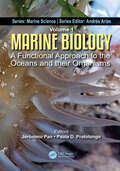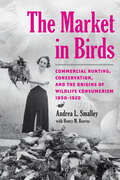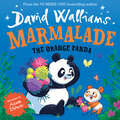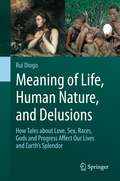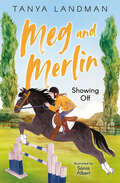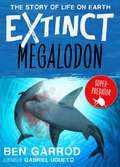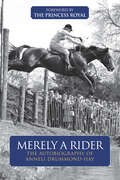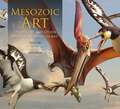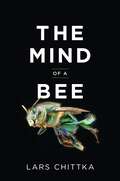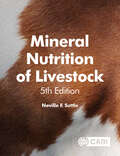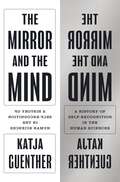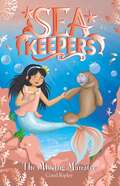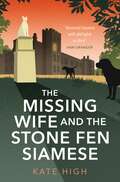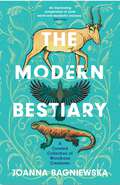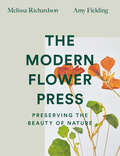- Table View
- List View
Manual of Equine Lameness
by Gary M. BaxterMANUAL OF EQUINE LAMENESS Discover a concise and accessible guide to diagnosing and managing lameness in horses The revised Second Edition of Manual of Equine Lameness offers a concise and accessible manual of lameness diagnosis and treatment in horses. Perfect for use as a quick reference, this book provides straightforward access to the essentials of equine lameness, including the clinical assessment of the horse and commonly performed diagnostic nerve blocks and the most common conditions of the foot, forelimb, and hindlimb that may be contributing to the lameness. Current therapeutic options to treat lameness are also discussed, as well as guidance on how to manage musculoskeletal emergencies. The content has been distilled from the authoritative Seventh Edition of Adams and Stashak’s Lameness in Horses, and this new edition has been re-envisioned to be even quicker and easier to navigate than the previous version. Color photographs and illustrations support the text, which presents lameness information most relevant to equine general practitioners, mixed animal practitioners, and veterinary students. A companion website offers videos that focus on the clinical examination of the horse and select diagnostic blocks and relevant anatomy. Diagnostic and treatment material has been revised from the previous edition to include the most up-to-date information. Readers will find: A thorough introduction to the assessment of the lame horse, including history, visual exam, palpation, subjective and objective assessments of lameness, perineural anesthesia, and intrasynovial anesthesia An exploration of common conditions of the foot, including the navicular region and soft tissue injuries, coffin joint and distal phalanx conditions, and laminitis Discussions of the most common conditions of the forelimb, including the pastern, fetlock, metacarpus/metatarsus, carpus, antebrachium, elbow, and humerus, as well as the shoulder and scapula Discussions of common conditions of the hindlimb and axial skeleton A review of therapeutic options to treat lameness conditions How to manage musculoskeletal emergencies in the horse Ideal for veterinary students, early career equine practitioners, and mixed animal veterinarians, the Second Edition of Manual of Equine Lameness is an indispensable reference for any veterinarian seeking a concise one-stop reference for equine lameness.
Manual of Equine Nutrition and Feeding Management
by Carol Z. Buckhout Barbara E. LindbergManual of Equine Nutrition and Feeding ManagementS A practical manual for applied labs on the nutrition and feeding of horses In the Manual of Equine Nutrition and Feeding Management, a team of equine nutritionists and educators delivers a comprehensive manual perfect for use in an applied laboratory setting. This book explores critical ideas in equine nutrition, from plant identification to determining the cost of feeding. The laboratory concepts and assignments contained within this book combine the practical aspects of feeds and feeding with the technical aspects of equine nutrition. Each chapter is organized to include an introduction, objectives, and questions for further study; and is supplemented with additional activities to aid in the retention of the presented material. A companion website provides worksheets, with an instructor key with answers to the lab activities and assignments available to instructors. The book also includes: A thorough introduction to the equine digestive system, including the primary and secondary organs of digestion Comprehensive explorations of plant identification, pasture, hay, and concentrates for horses Practical discussions of by-product feeds and additives, including explanations of the concepts of “as sampled” and “dry matter” In-depth examinations of how to determine the nutrient content of feeds and the use of feeding standards and English-metric conversions Ideal for pre-veterinary and equine studies students, the Manual of Equine Nutrition and Feeding Management is also an indispensable resource for veterinary medicine and veterinary technician students, equine nutritionists, and the owners and breeders of horses.
Manual of Equine Nutrition and Feeding Management
by Carol Z. Buckhout Barbara E. LindbergManual of Equine Nutrition and Feeding ManagementS A practical manual for applied labs on the nutrition and feeding of horses In the Manual of Equine Nutrition and Feeding Management, a team of equine nutritionists and educators delivers a comprehensive manual perfect for use in an applied laboratory setting. This book explores critical ideas in equine nutrition, from plant identification to determining the cost of feeding. The laboratory concepts and assignments contained within this book combine the practical aspects of feeds and feeding with the technical aspects of equine nutrition. Each chapter is organized to include an introduction, objectives, and questions for further study; and is supplemented with additional activities to aid in the retention of the presented material. A companion website provides worksheets, with an instructor key with answers to the lab activities and assignments available to instructors. The book also includes: A thorough introduction to the equine digestive system, including the primary and secondary organs of digestion Comprehensive explorations of plant identification, pasture, hay, and concentrates for horses Practical discussions of by-product feeds and additives, including explanations of the concepts of “as sampled” and “dry matter” In-depth examinations of how to determine the nutrient content of feeds and the use of feeding standards and English-metric conversions Ideal for pre-veterinary and equine studies students, the Manual of Equine Nutrition and Feeding Management is also an indispensable resource for veterinary medicine and veterinary technician students, equine nutritionists, and the owners and breeders of horses.
Manual to Veterinary Video-Oto-Endoscopy: Use and Utility in Canine and Feline Ear Diseases
by Giovanni GhibaudoThis atlas provides a step-by-step manual in using the video-oto-endoscope (VOE) as a tool to study ear diseases in cats and dogs. Illustrated by numerous high-resolution images and case studies, the book explains in a highly accessible manner when and how to use VOE. It teaches how to differ between a normal and a pathological animal ear and guides the reader in diagnosing a particular disease. The book's main section provides in-depth information on causes, clinical picture, and imaging of ear diseases such as acute otitis externa, chronic otitis externa, and otitis media in small animals. Moreover, the atlas introduces technical fundamentals of the instrument and gives tips for its correct handling and cleaning. Further, readers are instructed on how to best prepare the animal patient for examination by VOE. The atlas addresses veterinary practitioners and veterinary technicians who are interested in performing otological examinations in cats and dogs.
Marine Biology: A Functional Approach to the Oceans and their Organisms (Marine Science Series)
by Jerónimo Pan Paula PratolongoWe present you with an updated reference book aimed for upper-level undergraduate and graduate students interested in Marine Biology. The textbook is designed to introduce the fundamentals of marine organisms and their ecological roles in the world’s oceans, and is organized by functional groups, emphasizing marine biodiversity rather than systematics or habitats. Each chapter has been written and peer-reviewed by renowned international experts in their respective fields, and includes updated information on relevant topics, from the microbial loop and primary production in the oceans, to marine megafauna and the impacts of projected climate change on marine life and ecosystems.
Marine Biology: A Functional Approach to the Oceans and their Organisms (Marine Science Series)
by Jerónimo PanWe present you with an updated reference book aimed for upper-level undergraduate and graduate students interested in Marine Biology. The textbook is designed to introduce the fundamentals of marine organisms and their ecological roles in the world’s oceans, and is organized by functional groups, emphasizing marine biodiversity rather than systematics or habitats. Each chapter has been written and peer-reviewed by renowned international experts in their respective fields, and includes updated information on relevant topics, from the microbial loop and primary production in the oceans, to marine megafauna and the impacts of projected climate change on marine life and ecosystems.
Marine Mammals: the Evolving Human Factor (Ethology and Behavioral Ecology of Marine Mammals)
by Giuseppe Notarbartolo di Sciara Bernd WürsigThe seventh volume in the series “Ethology and Behavioral Ecology of Marine Mammals” describes aspects of the often-complex relationship between humans and marine mammals. From a primeval condition of occasional predators, during the last century humans have become a major factor negatively affecting the status of most marine mammals through over-hunting, habitat encroachment and environmental degradation. This has led to the extirpation of many marine mammal populations and even to the extinction of species. However, in parallel to this destructive drive, since antiquity humanity has been influenced by a strong fascination for marine mammals, which contributes today to an increased human appreciation of the natural world admixed with widespread concern for its degrading condition. The special status occupied by marine mammals in human imagination and affection stands in stark contrast with the current predicament of many populations still threatened by the doings of Homo sapiens: a condition emblematic of the relationship of humanity with nature, and key to understanding where humanity is heading.
The Market in Birds: Commercial Hunting, Conservation, and the Origins of Wildlife Consumerism, 1850–1920
by Andrea L. SmalleyA fascinating look at how a commercial market for birds in the late nineteenth century set the stage for conservation and its legislation.Between the end of the Civil War and the 1920s, the United States witnessed the creation, rapid expansion, and then disappearance of a commercial market for hunted wild animals. The bulk of commercial wildlife sales in the last part of the nineteenth century were of wildfowl, who were prized not only for their eggs and meat but also for their beautiful feathers. Wild birds were brought to cities in those years to be sold as food for customers' tables, decorations for ladies' hats, treasured pets, and specimens for collectors' cabinets. Though relatively short-lived, this market in birds was broadly influential, its rise and fall coinciding with the birth of the Progressive Era conservation movement. In The Market in Birds, historian Andrea L. Smalley and wildlife biologist Henry M. Reeves illuminate this crucial chapter in American environmental history. Touching on ecology, economics, law, and culture, the authors reveal how commercial hunting set the terms for wildlife conservation and the first federal wildlife legislation at the turn of the twentieth century. Smalley and Reeves delve into the ground-level interactions among market hunters, game dealers, consumers, sportsmen, conservationists, and the wild birds they all wanted. Ultimately, they argue, wildfowl commercialization represented a revolutionary shift in wildlife use, turning what had been a mostly limited, local, and seasonal trade into an interstate industrial-capitalist enterprise. In the process, it provoked a critical public debate over the value of wildlife in a modern consumer culture. By the turn of the twentieth century, the authors reveal, it was clear that wild bird populations were declining precipitously all over North America. The looming possibility of a future without birds sparked intense debate nationwide and eventually culminated in the 1918 Migratory Bird Treaty Act. Scholars, environmentalists, wildlife professionals, and anyone concerned about wildlife will find this new perspective on conservation history enlightening reading.
Marmalade: The Orange Panda
by David WalliamsCuddle up and laugh with this heart-warming and funny new children’s picture book from number-one bestselling author David Walliams, gloriously illustrated by the awesome Adam Stower!
McCurnin's Clinical Textbook for Veterinary Technicians and Nurses E-Book
by Joanna M. BassertMaster all the animal care duties of a veterinary technician! McCurnin's Clinical Textbook for Veterinary Technicians and Nurses, 10th Edition provides a solid foundation in every aspect of veterinary technology, including care of small and large animals, birds, reptiles, and small mammals. Procedure boxes offer step-by-step guidelines to performing key tasks, and use of the veterinary technician practice model helps to improve your critical thinking and decision-making skills. Written by vet tech experts Joanna Bassert, Angela Beal, and Oreta Samples, this illustrated guide prepares you for success on the Veterinary Technician National Exam (VTNE®) and in clinical practice.2017 winner of the William Holmes McGuffey Longevity Award ("McGuffey") from the Text & Academic Authors Association (TAA), which recognizes textbooks and learning materials whose excellence has been demonstrated over time.Case presentations provide real-life scenarios, so students can practice critical thinking and decision-making skills.Step-by-step instructions show students how to perform dozens of procedures, making information easy to access in emergency and clinical situations.More than 1,000 full-color photographs and line drawings depict veterinary technology concepts and techniques.Chapter outline, learning objectives, and key terms begin each chapter, focusing study on need-to-know material.Technician Notes highlight key points relating to the role of the veterinary technician.Coverage of large animal care is integrated throughout the book, including medical records, dentistry, physical examination, surgical instrumentation, surgical assistance, emergency care, and euthanasia, as well as separate Large Animal chapters.Comprehensive chapters on pharmacology, pain management, restraint, and veterinary oncology provide a broader understanding of the responsibilities of a technician.Coverage of zoonotics is threaded throughout each chapter, describing how a disease may affect the host, how it is spread, how it is treated, and the necessary safety precautions.Care of Birds, Reptiles, and Small Mammals chapter describes care and treatment of these increasingly popular pets.Student workbook reinforces understanding with review questions, case presentations, and clinical applications, as well as photo-based quizzes and other student exercises. Available separately.
Meaning of Life, Human Nature, and Delusions: How Tales about Love, Sex, Races, Gods and Progress Affect Our Lives and Earth's Splendor
by Rui DiogoWhatever are your beliefs, background, education, political views or interests, one thing is sure: this book will engage you, teach you something new, and more importantly make you to re-think deeply about critical aspects of your daily-life, including sex, love, food, physical activities, diseases, work and stress, and how you see and deal with other people, other animals, and the planet in general. Indeed, it focuses on topics that have fascinated people from all places and historical periods since times immemorial: Why are we here? What is the meaning of life? Are we progressing, and will we thrive? It does this by integrating in a unique fashion information from ancient Greek, Sumerian, Hindu, Jewish, Buddhist, Christian and Muslim texts to high-tech brain research, facts about near-death experiences, Covid-19, QAnon conspiracies, virtual reality and dating aps; from Adam and Eve to the rise of misogyny and racism to Black Lives Matter, Me-Too, Hollywood romantic movies and Disney fairy-tales. Contrary to notions about 'human progress' and 'Homo Deus' defended by authors such as Harari, Pinker and Dawkins, it shows that human history instead involves the repetition of similar imaginary tales created by a combination of traits found in other animals and the uniquely human obsession about 'cosmic purpose' stories related to our awareness of death's inevitability. Organized religions appeared later, chiefly during the rise of agriculture and 'civilizations'. Diogo navigates mesmerizing untold stories revealing a paradox: these events and the industrial 'revolution' increased inequality, oppression, slavery, subjugation of women, famines, plagues, 'work', stress, and suicides. Data from psychology, biology, neurobiology, and cross-cultural studies of hunter-gatherers and so-called 'developed' societies reveal an even more profound paradox: within all forms of life, the 'sapient being' is the one immersed in Neverland's world of unreality - truly a Homo irrationalis, fictus and socialis believing in fictional tales about cosmic 'duties', 'romantic meant to be', demons, inferior 'races' and 'genders', conspiracies, and 'justified' slavery, warfare, genocides, and animal abuses. Importantly, such tales play, on the other hand, crucial functions such as help coping with death and a plethora of societal troubles, decreasing stress, or preventing drug and alcohol abuse. An optimist and passionate wondered and wanderer, Diogo provides enthralling details about the history of religion, discrimination, romantic love, warfare, diseases and Earth's biodiversity illustrating how 'virtue is in the middle' and that we - with our intriguing combination of beliefs, bodily needs and desires, artistic abilities, and mismatches between our senses' illusions and the cosmos' reality - are not 'better' or 'worse' than the other millions of captivating living species. This powerful and urgently needed message has critical repercussions for how we understand, care about, and mindfully enjoy living in this splendid planet, in the reality of here and now.Pre-publication comments: "I applaud the enormous work that Diogo has invested in this follow-up to his widely acclaimed Evolution driven by organismal behavior book, and the challenge of getting people to think beyond and outside of our usual set of definitions and expectations. The case-studies provided in the book are fascinating and insightful" (Drew Noden, Award-winning Emeritus Professor, Cornell University)"Rui Diogo is becoming the Slavoj Zizek of evolutionary biology" (Marcelo Sanchez-Villagra, Director of the Paleontological Institute and Museum of the University of Zurich)
Medicine and Surgery of Camelids
by Andrew J. NiehausA thoroughly updated new edition of the classic veterinary reference In the newly revised Fourth Edition of Medicine and Surgery of Camelids, accomplished veterinary surgeon, Dr. Andrew J. Niehaus delivers a comprehensive reference to all aspects of camelid medicine and surgery. The book covers general husbandry, restraint, nutrition, diagnosis, anesthesia, surgery, and the treatment of specific diseases veterinarians are likely to encounter in camelid patients. Although the focus of the text remains on llamas and alpacas, camel-specific information has received more attention than in previous editions with a chapter dedicated to old-world camelids. The editor revitalizes the emphasis on evidence-based information and pathophysiology and draws on the experience of expert contributors to provide up-to-date and authoritative material on nutrition, internal medicine, and more. A classic text of veterinary medicine, this latest edition comes complete with high-quality color photographs and access to a companion website that offers supplementary resources. Readers will also find: A thorough introduction to the general biology and evolution of camelids, as well as their husbandry and handling Comprehensive explorations of camelid physical exams, diagnostics, anesthesia, pain management, and surgery Topical discussions arranged by body system including the integumentary system, the musculoskeletal system and multisystem disorders Chapters dedicated to camelid radiology, parasitology, and diagnostic clinical pathology In-depth examinations of camelid toxicology, neonatology, and congenital diseases Perfect for veterinary specialists and general practitioners, Medicine and Surgery of Camelids will also earn a place in the libraries of veterinary students and trainees with an interest in camelids.
Medicine and Surgery of Camelids
by Andrew J. NiehausA thoroughly updated new edition of the classic veterinary reference In the newly revised Fourth Edition of Medicine and Surgery of Camelids, accomplished veterinary surgeon, Dr. Andrew J. Niehaus delivers a comprehensive reference to all aspects of camelid medicine and surgery. The book covers general husbandry, restraint, nutrition, diagnosis, anesthesia, surgery, and the treatment of specific diseases veterinarians are likely to encounter in camelid patients. Although the focus of the text remains on llamas and alpacas, camel-specific information has received more attention than in previous editions with a chapter dedicated to old-world camelids. The editor revitalizes the emphasis on evidence-based information and pathophysiology and draws on the experience of expert contributors to provide up-to-date and authoritative material on nutrition, internal medicine, and more. A classic text of veterinary medicine, this latest edition comes complete with high-quality color photographs and access to a companion website that offers supplementary resources. Readers will also find: A thorough introduction to the general biology and evolution of camelids, as well as their husbandry and handling Comprehensive explorations of camelid physical exams, diagnostics, anesthesia, pain management, and surgery Topical discussions arranged by body system including the integumentary system, the musculoskeletal system and multisystem disorders Chapters dedicated to camelid radiology, parasitology, and diagnostic clinical pathology In-depth examinations of camelid toxicology, neonatology, and congenital diseases Perfect for veterinary specialists and general practitioners, Medicine and Surgery of Camelids will also earn a place in the libraries of veterinary students and trainees with an interest in camelids.
Meg and Merlin: Showing Off (Meg and Merlin #2)
by Tanya LandmanA new friend helps Meg to realise that appearances aren’t always what they seem in this exciting new addition to Tanya Landman’s delightful horse-riding series.
Megalodon (Extinct the Story of Life on Earth #6)
by Ben GarrodTV scientist Ben Garrod presents the biggest extinction events ever, told from the point of view of evolution's superstars, the most incredible animals ever to swim, stalk, slither or walk our planet. Whether you're 9 or 90, his unique exploration of the most destructive, yet most creative, force in nature makes top level science fun. Here are the superstars of the story of life, from the super-weird to the super-ferocious. Usually a species has 10 million years or so of evolving, eating, chasing, playing, maybe doing homework, or even going to the moon before it goes extinct.Megalodon, the super-predator, had the most powerful bite force ever measured! Terrorising the oceans, it hunted with stealth and skill, but even Megalodon died out, along with 50 percent of marine mammals, 2.5 million years ago. Find out why!Collect all eight books about animals we have lost in mass extinctions caused by asteroids or mega-volcanoes, clashing continents and climate change.Also includes: * Past brought to full-colour life by palaeoartist Gabriel Ugueto * Ask an Expert contributions from leading scientists * Glossary and pronunciation guide
Merely A Rider: The Autobiography of Anneli Drummond-Hay
by Anneli Drummond-HayAnneli Drummond-Hay’s autobiography is a fascinating insight into the making of an equestrian champion through her struggle for survival. It is a heart-warming story of a war baby with aristocratic connections, who grew up with very little money and even less love. She never went to school, she had no friends growing up, but she did have a gift with the horses in which she sought solace. The big love story of her life was one particularly special horse, Merely-A-Monarch. He was invincible in eventing, but as female eventers were not permitted to compete in the Olympics in that era, Anneli switched to show jumping. She came so close to going to three Olympics but was foiled at the last moment each time, despite winning just about everything else in the sport. Besides her wonderful horses, Anneli gives an amazing account of the people she met – from Harvey Smith to the Queen, in front of whom she was asked to lend her horse for the British Olympic effort, and refused; to her asking a favour, in person, of Colonel Gaddafi. The jet-set life of an elite show jumper may be glamorous but there are more lows than highs, whether it’s her top ride being stolen, a potential plane disaster above the Alps, or the sudden death of a star horse. As The Princess Royal so rightly says in the foreword to this book: ‘Thank goodness Anneli decided to write her story.’
Mesozoic Art: Dinosaurs and Other Ancient Animals in Art
by Steve White Darren NaishShowcases the work of twenty leading paleoartists who expertly bring these extinct animals to life in exquisite detail.Dinosaurs are endlessly fascinating to people of every age, from the youngest child who enjoys learning the tongue-twisting names to adults who grew up with Jurassic Park and Walking with Dinosaurs. As our knowledge of the prehistoric world continues to evolve and grow, so has the discipline of bringing these ancient worlds to life artistically. Paleoart puts flesh on the bones of long-extinct organisms, and illustrates the world they lived in. Mesozoic Art presents twenty of the best artists working in this field, representing a broad spectrum of disciplines, from traditional painting to cutting-edge digital technology. Some provide the artwork for new scientific papers that demand high-end paleoart as part of their presentation to the world at large; they also work for the likes of National Geographic and provide art to museums around the world to illustrate their displays. Other artists are the new rising stars of paleoart in an ever-growing, ever-diversifying field. Arranged by portfolio, this book brings this dramatic art to a wide, contemporary audience. The art is accompanied by text on the animals and their lives, written by palaeontologist Darren Naish. Paleoart is dynamic, fluid and colourful, as were the beasts it portrays, which are displayed in this magnificent book.
The Mind of a Bee
by Lars ChittkaA rich and surprising exploration of the intelligence of bees Most of us are aware of the hive mind—the power of bees as an amazing collective. But do we know how uniquely intelligent bees are as individuals? In The Mind of a Bee, Lars Chittka draws from decades of research, including his own pioneering work, to argue that bees have remarkable cognitive abilities. He shows that they are profoundly smart, have distinct personalities, can recognize flowers and human faces, exhibit basic emotions, count, use simple tools, solve problems, and learn by observing others. They may even possess consciousness.Taking readers deep into the sensory world of bees, Chittka illustrates how bee brains are unparalleled in the animal kingdom in terms of how much sophisticated material is packed into their tiny nervous systems. He looks at their innate behaviors and the ways their evolution as foragers may have contributed to their keen spatial memory. Chittka also examines the psychological differences between bees and the ethical dilemmas that arise in conservation and laboratory settings because bees feel and think. Throughout, he touches on the fascinating history behind the study of bee behavior.Exploring an insect whose sensory experiences rival those of humans, The Mind of a Bee reveals the singular abilities of some of the world’s most incredible creatures.
Mineral Nutrition of Livestock
by Neville SuttleThe fifth edition of this important book reviews recent advances in livestock mineral nutrition, updated throughout with new references that reflect the growing complexity of mineral metabolism. Major related themes covered include the assessment of the 'mineral value' of feeds, the false hopes placed on organic mineral supplements and limiting the 'mineral footprint' of livestock production to lower environmental pollution. Also discussed are new developments and concepts including: Salt tolerance and optimizing production in salt-rich environments. Use of phytase rather than phosphate supplements in pig and poultry rations. Demineralization of the skeleton during confinement. Recognition of sub-acute, clinical hypocalcaemia as a disorder in dairy cows. The assay of 'free' plasma B12 to assess cobalt status of cattle. Limitations of cell culture and ligated loop techniques for assessing bioavailability. Following a clear and easy to reference structure, the book also considers potential pitfalls, such as misleading estimates of mineral requirements for growth, and misinterpretation of genomic markers for mineral requirements and bioavailability of supplements. An essential resource for researchers and students in animal nutrition, agriculture and veterinary medicine, this book also forms a useful reference for veterinary practitioners and those concerned with human nutrition and environmental protection.
The Mirror and the Mind: A History of Self-Recognition in the Human Sciences (Princeton Modern Knowledge Ser. #2)
by Professor Katja GuentherHow the classic mirror test served as a portal for scientists to explore questions of self-awarenessSince the late eighteenth century, scientists have placed subjects—humans, infants, animals, and robots—in front of mirrors in order to look for signs of self-recognition. Mirrors served as the possible means for answering the question: What makes us human? In The Mirror and the Mind, Katja Guenther traces the history of the mirror self-recognition test, exploring how researchers from a range of disciplines—psychoanalysis, psychiatry, developmental and animal psychology, cybernetics, anthropology, and neuroscience—came to read the peculiar behaviors elicited by mirrors. Investigating the ways mirrors could lead to both identification and misidentification, Guenther looks at how such experiments ultimately failed to determine human specificity.The mirror test was thrust into the limelight when Charles Darwin challenged the idea that language sets humans apart. Thereafter the mirror, previously a recurrent if marginal scientific tool, became dominant in attempts to demarcate humans from other animals. But because researchers could not rely on language to determine what their nonspeaking subjects were experiencing, they had to come up with significant innovations, including notation strategies, testing protocols, and the linking of scientific theories across disciplines. From the robotic tortoises of Grey Walter and the mark test of Beulah Amsterdam and Gordon Gallup, to anorexia research and mirror neurons, the mirror test offers a window into the emergence of such fields as biology, psychology, psychiatry, animal studies, cognitive science, and neuroscience.The Mirror and the Mind offers an intriguing history of experiments in self-awareness and the advancements of the human sciences across more than a century.
The Mirror and the Mind: A History of Self-Recognition in the Human Sciences (Princeton Modern Knowledge Ser. #2)
by Professor Katja GuentherHow the classic mirror test served as a portal for scientists to explore questions of self-awarenessSince the late eighteenth century, scientists have placed subjects—humans, infants, animals, and robots—in front of mirrors in order to look for signs of self-recognition. Mirrors served as the possible means for answering the question: What makes us human? In The Mirror and the Mind, Katja Guenther traces the history of the mirror self-recognition test, exploring how researchers from a range of disciplines—psychoanalysis, psychiatry, developmental and animal psychology, cybernetics, anthropology, and neuroscience—came to read the peculiar behaviors elicited by mirrors. Investigating the ways mirrors could lead to both identification and misidentification, Guenther looks at how such experiments ultimately failed to determine human specificity.The mirror test was thrust into the limelight when Charles Darwin challenged the idea that language sets humans apart. Thereafter the mirror, previously a recurrent if marginal scientific tool, became dominant in attempts to demarcate humans from other animals. But because researchers could not rely on language to determine what their nonspeaking subjects were experiencing, they had to come up with significant innovations, including notation strategies, testing protocols, and the linking of scientific theories across disciplines. From the robotic tortoises of Grey Walter and the mark test of Beulah Amsterdam and Gordon Gallup, to anorexia research and mirror neurons, the mirror test offers a window into the emergence of such fields as biology, psychology, psychiatry, animal studies, cognitive science, and neuroscience.The Mirror and the Mind offers an intriguing history of experiments in self-awareness and the advancements of the human sciences across more than a century.
The Missing Manatee: Book 9 (Sea Keepers #9)
by Coral RipleySea Keepers to the rescue - a baby manatee needs their help! A magical series about saving our oceans.Emily, Grace and Layla travel to the tropics to search for a magic pearl. But disaster strikes when evil Effluvia kidnaps a baby manatee and holds it for ransom. Effluvia demands a magic pearl in exchange for the little manatee. If the Sea Keepers give into the wicked siren, they won't be able to stop her from releasing her siren sisters . . . It's up to the Sea Keepers to save the manatee - and the whole underwater world!
The Missing Wife and the Stone Fen Siamese: a heartwarming cosy crime book, perfect for animal lovers
by Kate High'Animal lovers will delight' Ann Granger on The Cat and the Corpse in the Old Barn'A real treat . . . I loved it. Cats, dogs, murder and a credible and relatable heroine' Barbara Nadel onThe Cat and the Corpse in the Old Barn Driving home from a ceramics evening class, Clarice Beech reflects on the absence of one of her students, Colin Compton-Smythe. Later, Emily, Colin's daughter, telephones to say her father has died during routine surgery. Distraught, Emily opens up to Clarice about his wretched childhood and the day five-year-old Colin returned home to discover Avril, his mother, gone. Colin never believed she would have left without him and had been trying to find out more about Avril's disappearance all those years ago.Clarice readily agrees to accompany Emily to Colin's funeral. On arriving at the stunning Victorian Gothic manor house, with Bellatrix, the majestic stone Siamese cat reposing at its entrance, Clarice soon becomes drawn into the fractious world of the Compton-Smythe family: Colin's argumentative father Ralph and his equally combative partner Tessa, their daughter, Dawn, being stalked by an ex-lover and, most unsettling of all, Ernestine, Ralph's emotionally unpredictable sister. And then there's Johnson, Ralph's menacing manservant.Clarice discovers the nearer she gets to the truth, the greater she is in danger as somebody is intent that the mystery of the missing wife should never be resolved.
The Modern Bestiary: A Curated Collection of Wondrous Creatures
by Joanna Bagniewska'An illuminating compendium of some weird and wonderful creatures.' ObserverFrom the familiar to the improbable, the gross to the endearing, The Modern Bestiary is a compendium of curious creatures. It includes both animals that have made headlines and those you've probably never heard of, such as skin-eating caecilians, harp sponges, or zombie worms - also known as bone-eating snot flowers. Arranged by elements (Earth, Water, Air), The Modern Bestiary contains well-known species told from new, unexpected angles (rats that drive cars; fish that communicate by passing wind), as well as stranger and lesser-known creatures, including carnivorous mice that howl at the moon, cross-dressing cuttlefish, and antechinuses - small marsupials that literally mate themselves to death. Finally, there are the 'aliens on Earth' - the incredible, the surreal, the magical - such as tardigrades, tongue-eating lice and immortal jellyfish, creatures so astonishing that they make unicorns look rather commonplace.Written by a zoologist with a flair for storytelling, this is a fascinating celebration of the animal kingdom.' [A] beautifully written book to make you laugh, squirm and - perhaps most importantly - appreciate how lucky we are to not have to live inside an anus.' Yussef Rafik'The Modern Bestiary provides a fascinating, accessible and humorous insight into the wonders of the natural world.' Amy Dickman, director of Oxford University's Wildlife Conservation Research Unit 'If you love animals, especially ones with unsavoury habits, this book is for you. Entries are crafted with affection, cast-iron scholarship and an unyielding dedication to exposing as much hilarious weirdness as the animal kingdom can offer.' Tom Moorhouse, author of Elegy for a River'Everyone who loves wildlife - especially fantastically weird and cringingly gross wildlife - should read this masterful book.' Mark Carwardine, author/presenter of Last Chance to See'If ever there was a book that highlighted the bewildering wonders of the natural world, and the need for their conservation, this is it.' Michael Brooke, author of Far from Land
The Modern Flower Press: Preserving The Beauty Of Nature
by Melissa Richardson Amy FieldingA contemporary, beautifully illustrated book on flowers, flower pressing and arranging.



